Non-Linear Optical Property and Biological Assays of Therapeutic Potentials Under In Vitro Conditions of Pd(II), Ag(I) and Cu(II) Complexes of 5-Diethyl amino-2-({2-[(2-hydroxy-Benzylidene)-amino]-phenylimino}-methyl)-phenol
Abstract
:1. Introduction
2. Experimental
2.1. Formation of the Schiff Base H2L Ligand
2.2. Formation of the CuL Complex
2.3. Synthesis of the PdL Complex
2.4. Formation of the AgL Complex
2.5. Estimation of the Stoichiometry of the Title Imine Complexes
2.6. Estimation of Apparent Stability Constant of the Titled Complexes
2.7. Kinetic Parameters of the Titled Complexes
2.8. Density Functional Theoretical
2.9. Antimicrobial Activity of the Prepared Compounds
2.10. CT-DNA Binding Study
2.10.1. Electronic Spectroscopy
2.10.2. Dynamic Viscosity Measurements
2.10.3. Gel Electrophoresis
2.11. Molecular Docking Studies
2.12. Cytotoxicity
3. Results and Discussion
3.1. H- and 13C-NMR Spectra
3.2. Infrared (IR) Spectra
3.3. Evaluation of the Stoichiometry of the New Complexes
3.4. Elemental Analyses and Conductivity Measurements
3.5. Magnetic Measurements
3.6. Electronic Spectroscopy
3.7. TGA Studies
Kinetic Parameter for Thermal Analysis of the New Complexes
3.8. The Stability Range of the New Complexes
3.9. MO Calculations
3.9.1. Geometry of the Ligand
3.9.2. Geometry of the Prepared Complexes
3.9.3. Natural Population and Charges
3.9.4. Non-Linear Optical Properties
3.9.5. Quantum Global Reactivity Descriptors
3.10. Antimicrobial Activity
3.11. CT-DNA Binding of the New Complexes
3.11.1. Electronic Spectra of CT-DNA Complex Titration
3.11.2. Dynamic Viscosity Measurement
3.11.3. Gel Electrophoresis
3.11.4. Suggested Mechanisms of the Interaction of the New Metal Complexes with DNA
3.12. Molecular Docking
3.13. In Vitro Cytotoxicity
4. Summary and Conclusions
Supplementary Materials
Author Contributions
Funding
Acknowledgments
Conflicts of Interest
References
- Abu-Surrah, A.S.; Kettunen, M. Platinum Group Antitumor Chemistry: Design and development of New Anticancer Drugs Complementary to Cisplatin. Curr. Med. Chem. 2006, 13, 1337–1357. [Google Scholar] [CrossRef] [PubMed]
- Jakupec, M.A.; Galanski, M.; Arion, V.B.; Hartinger, C.G.; Keppler, B.K. Antitumour metal compounds: More than theme and variations. Dalton Trans. 2008, 14, 183–194. [Google Scholar] [CrossRef] [PubMed]
- Hadjikakou, S.K.; Hadjiliadis, N. Antiproliferative and anti-tumor activity of organotin compounds. Co-ord. Chem. Rev. 2009, 253, 235–249. [Google Scholar] [CrossRef]
- Strohfeldt, K.; Tacke, M. Bioorganometallic fulvene-derived titanocene anti-cancer drugs. Chem. Soc. Rev. 2008, 37, 1174–1187. [Google Scholar] [CrossRef] [PubMed]
- Wang, M.; Zhu, H.; Jin, K.; Dai, D.; Sun, L. Ethylene oligomerization by salen-type zirconium complexes to low-carbon linear α-olefins. J. Catal. 2003, 220, 392–398. [Google Scholar] [CrossRef]
- Marchetti, F.; Pettinari, C.; Pettinarib, R.; Cingolani, A.; Leonesi, D.; Lorenzotti, A. Group 12 metal complexes of tetradentate N2O2–Schiff-base ligands incorporating pyrazole. Polyhedron 1999, 18, 3041–3050. [Google Scholar] [CrossRef]
- Hökelek, T.; Kılıç, Z.; Isıklan, M.; Toy, M. Intramolecular hydrogen bonding and tautomerism in Schiff bases. Part II. Structures of 1-[N-(2-pyridyl)aminomethylidene}-2(1H)-naphtalenone (1) and bis[2-hydroxy-κO–N-(2-pyridyl)-1-naphthaldiminato-κN]zinc(II) (2). J. Mol. Struct. 2000, 523, 61–69. [Google Scholar] [CrossRef]
- Shaghaghi, Z.; Kalantari, N.; Kheyrollahpoor, M.; Haeili, M. Optical, electrochemical, thermal, biological and theoretical studies of some chloro and bromo based metal-salophen complexes. J. Mol. Struct. 2020, 1200, 127107. [Google Scholar] [CrossRef]
- Prasad, K.S.; Kumar, L.S.; Chandan, S.; Kumar, R.N.; Revanasiddappa, H.D. Palladium(II) complexes as biologically potent metallo-drugs: Synthesis, spectral characterization, DNA interaction studies and antibacterial activity. Spectrochim. Acta Part A: Mol. Biomol. Spectrosc. 2013, 107, 108–116. [Google Scholar] [CrossRef]
- Shinde, M.P.; Toche, R.B.; Chavan, S.M.; Tambade, P.J. Synthesis and Characterization of Pd (II) Schiff Base Metal Complexes. Der Pharma Chem. 2016, 8, 287–293. [Google Scholar]
- Belicchi-Ferrari, M.; Bisceglie, F.; Buschini, A.; Franzoni, S.; Pelosi, G.; Pinelli, S.; Tarasconi, P.; Tavone, M. Synthesis, structural characterization and antiproliferative and toxic bio-activities of copper(II) and nickel(II) citronellal N4-ethylmorpholine thiosemicarbazonates. J. Inorg. Biochem. 2010, 104, 199–206. [Google Scholar] [CrossRef]
- Azócar, M.I.; Muñoz, H.; Levin, P.; Dinamarca, N.; Gómez, G.; Ibañez, A.; Garland, M.T.; Paez, M.A. Synthesis and characterization of silver(I) complexes with ligands having anti-inflammatory properties. Commun. Inorg. Synth. 2013, 1, 19–21. [Google Scholar]
- Klasen, H. Historical review of the use of silver in the treatment of burns. I. Early uses. Burn 2000, 26, 117–130. [Google Scholar] [CrossRef]
- Abdel-Rahman, L.H.; Abu-Dief, A.M.; Newair, E.F.; Hamdan, S.K. Some new nano-sized Cr(III), Fe(II), Co(II), and Ni(II) complexes incorporating 2-((E)-(pyridine-2-ylimino)methyl)napthalen-1-ol ligand: Structural characterization, electrochemical, antioxidant, antimicrobial, antiviral assessment and DNA interaction. J. Photochem. Photobiol. B: Biol. 2016, 160, 18–31. [Google Scholar] [CrossRef]
- Gass, I.A.; Gartshore, C.J.; Lupton, D.W.; Moubaraki, B.; Nafady, A.; Bond, A.M.; Boas, J.F.; Cashion, J.D.; Milsmann, C.; Wieghardt, K.; et al. Anion Dependent Redox Changes in Iron Bis-terdentate Nitroxide {NNO} Chelates. Inorg. Chem. 2011, 50, 3052–3064. [Google Scholar] [CrossRef] [PubMed]
- El-Lateef, H.M.A.; Abu-Dief, A.M.; Abdel-Rahman, L.; Sañudo, E.C.; Aliaga-Alcalde, N. Electrochemical and theoretical quantum approaches on the inhibition of C1018 carbon steel corrosion in acidic medium containing chloride using some newly synthesized phenolic Schiff bases compounds. J. Electroanal. Chem. 2015, 743, 120–133. [Google Scholar] [CrossRef]
- El-Lateef, H.M.A.; Abu-Dief, A.M.; Mohamed, M.A. Corrosion inhibition of carbon steel pipelines by some novel Schiff base compounds during acidizing treatment of oil wells studied by electrochemical and quantum chemical methods. J. Mol. Struct. 2017, 1130, 522–542. [Google Scholar] [CrossRef]
- Abdel-Rahman, L.H.; Adam, M.S.S.; Abu-Dief, A.M.; Moustafa, H.; Basha, M.T.; Aboraia, A.S.; Al-Farhan, B.S.; Ahmed, H.E.-S. Synthesis, theoretical investigations, biocidal screening, DNA binding, in vitrocytotoxicity and molecular docking of novel Cu (II), Pd (II) and Ag (I) complexes of chlorobenzylidene Schiff base: Promising antibiotic and anticancer agents. Appl. Organomet. Chem. 2018, 32, e4527. [Google Scholar] [CrossRef]
- Abdel-Rahman, L.H.; El-Khatib, R.M.; Abdel-Fatah, S.M.; Moustafa, H.; Alsalme, A.M.; Nafady, A. Novel Cr (III), Fe (III) and Ru (III) Vanillin Based Metallo-Pharmaceuticals for Cancer and Inflammation Treatment: Experimental and Theoretical Studies. Appl. Organomet. Chem. 2019, 33, 5177. [Google Scholar] [CrossRef]
- Abdel-Rahman, L.H.; Abu-Dief, A.M.; Moustafa, H.; Abdel-Mawgoud, A.A.H. Design and nonlinear optical properties (NLO) using DFT approach of new Cr(III), VO(II), and Ni(II) chelates incorporating tri-dentate imine ligand for DNA interaction, antimicrobial, anticancer activities and molecular docking studies. Arab. J. Chem. 2020, 13, 649–670. [Google Scholar] [CrossRef]
- Abdalla, E.M.; Rahman, L.H.A.; Abdelhamid, A.A.; Shehata, M.R.; Alothman, A.A.; Nafady, A. Synthesis, Characterization, Theoretical Studies, and Antimicrobial/Antitumor Potencies of Salen and Salen/Imidazole Complexes of Co (II), Ni (II), Cu (II), Cd (II), Al (III) and La (III). Appl. Organomet. Chem. 2020, 34. [Google Scholar] [CrossRef]
- Chandrasekhar, V.R.; Palsamy, K.M.; Lokesh, R.; Jegathalaprathaban, R.; Gurusamy, R. Biomolecular docking, antimicrobial and cytotoxic studies on new bidentate schiff base ligand derived metal (II) complexes. Appl. Organomet. Chem. 2018, 33, e4753. [Google Scholar] [CrossRef]
- Zhang, Y.-P.; Li, Y.; Xu, G.; Li, J.-Y.; Luo, H.-Y.; Zhang, L.; Jia, D.-Z. Synthesis, crystal structure, DNA/bovine serum albumin binding and antitumor activity of two transition metal complexes with 4-acylpyrazolone derivative. Appl. Organomet. Chem. 2019, 33, e4668. [Google Scholar] [CrossRef]
- Schaefer, T.; Wildman, T.A.; Salman, S.R. The perpendicular conformation of 2-hydroxythiophenol. Intramolecular hydrogen bonding to a specific lone pair. J. Am. Chem. Soc. 1980, 102, 107–110. [Google Scholar] [CrossRef]
- Clarke, T. Kids can leave the can open. Nat. Cell Biol. 2001, 60, 342. [Google Scholar] [CrossRef]
- Becke, A.D. Density-functional thermochemistry. III. The role of exact exchange. J. Chem. Phys. 1993, 98, 5648–5652. [Google Scholar] [CrossRef] [Green Version]
- Hay, P.J.; Wadt, W.R. Ab initio effective core potentials for molecular calculations. Potentials for the transition metal atoms Sc to Hg. J. Chem. Phys. 1985, 82, 270–283. [Google Scholar] [CrossRef]
- Reed, A.E.; Weinhold, F. Natural bond orbital analysis of near-Hartree–Fock water dimer. J. Chem. Phys. 1983, 78, 4066–4073. [Google Scholar] [CrossRef]
- Pearson, R.G. Absolute electronegativity and hardness correlated with molecular orbital theory. Proc. Natl. Acad. Sci. USA 1986, 83, 8440–8441. [Google Scholar] [CrossRef] [Green Version]
- Chandra, A.K.; Uchimaru, T. Hardness Profile: A Critical Study. J. Phys. Chem. A 2001, 105, 3578–3582. [Google Scholar] [CrossRef]
- Chen, X.; Yan, F.; Wu, M.; Tian, H.B.; Li, S.X.; Shan, X.; Wang, K.; Li, Z.; Xu, K. Hyperconjugative effect on the electronic wavefunctions of ethanol. Chem. Phys. Lett. 2009, 472, 19. [Google Scholar] [CrossRef] [Green Version]
- Avcı, D. Second and third-order nonlinear optical properties and molecular parameters of azo chromophores: Semiempirical analysis. Spectrochim. Acta Part A Mol. Biomol. Spectrosc. 2011, 82, 37–43. [Google Scholar] [CrossRef]
- Avcı, D.; Başoğlu, A.; Atalay, Y. Ab initio HF and DFT calculations on an organic non-linear optical material. Struct. Chem. 2009, 21, 213–219. [Google Scholar] [CrossRef]
- Avcı, D.; Cömert, H.; Atalay, Y. Ab initio Hartree-Fock calculations on linear and second-order nonlinear optical properties of new acridine-benzothiazolylamine chromophores. J. Mol. Model. 2008, 14, 161–169. [Google Scholar] [CrossRef]
- Al Zoubi, W.; Al-Hamdani, A.A.S.; Ahmed, S.D.; Basheer, H.M.; Al-Luhaibi, R.S.A.; Dib, A.; Ko, Y. Synthesis, characterization, and antioxidant activities of imine compounds. J. Phys. Org. Chem. 2018, 31, e3916. [Google Scholar] [CrossRef]
- Abu-Dief, A.M.; Nassar, I.F.; Elsayed, W.H. Magnetic NiFe2O4nanoparticles: Efficient, heterogeneous and reusable catalyst for synthesis of acetylferrocene chalcones and their anti-tumour activity. Appl. Organomet. Chem. 2016, 30, 917–923. [Google Scholar] [CrossRef]
- Abdel-Rahman, L.H.; Abu-Dief, A.M.; Basha, M.; Abdel-Mawgoud, A.A.H. Three novel Ni(II), VO(II) and Cr(III) mononuclear complexes encompassing potentially tridentate imine ligand: Synthesis, structural characterization, DNA interaction, antimicrobial evaluation and anticancer activity. Appl. Organomet. Chem. 2017, 31. [Google Scholar] [CrossRef]
- Abu-Dief, A.M.; Abdel-Rahman, L.H.; Shehata, M.R.; Abdel-Mawgoud, A.A.H. Novel azomethine Pd (II)- and VO (II)-based metallo-pharmaceuticals as anticancer, antimicrobial, and antioxidant agents: Design, structural inspection, DFT investigation, and DNA interaction. J. Phys. Org. Chem. 2019, 32. [Google Scholar] [CrossRef]
- Rohini, G.; Ramaiah, K.; Aneesrahman, K.N.; Aryasenan, M.C.; Bhuvanesh, N.S.P.; Reddy, K.L.; Sreekanth, A. Biological evaluation, DNA/protein-binding aptitude of novel dibenzosuberene appended palladium (II)-thiourea complexes. Appl. Organomet. Chem. 2018, 32, e4567. [Google Scholar] [CrossRef]
- Halgren, T.A. Merck molecular force field. I. Basis, form, scope, parameterization, and performance of MMFF94. J. Comput. Chem. 1996, 17, 490–519. [Google Scholar] [CrossRef]
- Abdel-Rahman, L.H.; Abu-Dief, A.M.; Shehata, M.R.; Atlam, F.M.; Abdel-Mawgoud, A.A.H. Some new Ag(I), VO(II) and Pd(II) chelates incorporating tridentate imine ligand: Design, synthesis, structure elucidation, density functional theory calculations for DNA interaction, antimicrobial and anticancer activities and molecular docking studies. Appl. Organomet. Chem. 2019, 33, e4699. [Google Scholar] [CrossRef]
- Abu-Dief, A.M.; Abdel-Rahman, L.H.; Abdel-Mawgoud, A.A.H. A robust in vitro Anticancer, Antioxidant and Antimicrobial Agents Based on New Metal-Azomethine Chelates Incorporating Ag(I), Pd (II) and VO (II) Cations: Probing the Aspects of DNA Interaction. Appl. Organomet. Chem. 2019, 34. [Google Scholar] [CrossRef]
- Gupta, S.K.; Anjana, C.; Sen, N.; Butcher, R.J.; Jasinski, J.P.; Golen, J.A. An unusual hydroxy-substituted mononuclear nickel(II) complex with a tetradentate Schiff base: Synthesis, spectroscopy, electrochemistry, crystallography, DNA binding, and theoretical investigation. Polyhedron 2015, 89, 219–231. [Google Scholar] [CrossRef]
- Sakthilatha, D.; Rajavel, R. The template synthesis, spectral and antibacterial investigation of new N2O2 donor Schiff base Cu(II), Ni(II), Co(II), Mn(II) and VO(IV) complexes derived from 2-Hydroxy acetophenone with 4-chloro-2,6-diaminopyrimidine. J. Chem. Pharm. Res. 2013, 5, 57–63. [Google Scholar]
- Gavali, L.V. Synthesis and Studies of Mixed Ligand Ni(II) and Cu(II) Metal Complexes with 2-Aminophenol and Schiff base of Terephthalaldehyde. Int. J. Eng. Techol. Manag. Appl. Sci. 2016, 4, 2349–4476. [Google Scholar]
- Abdel-Rahman, L.H.; Abu-Dief, A.M.; Moustafa, H.; Hamdan, S.K. Ni(II) and Cu(II) complexes with ONNO asymmetric tetradentate Schiff base ligand: Synthesis, spectroscopic characterization, theoretical calculations, DNA interaction and antimicrobial studies. Appl. Organomet. Chem. 2016, 31, e3555. [Google Scholar] [CrossRef]
- Dilip, C.S.; Sivakumar, V.; Prince, J.J. Synthesis and characterization of macrocyclic complexes of Co(II), Ni(II) and Cu(II). Ind. J. Chem. Technol. 2012, 19, 351–356. [Google Scholar]
- Hebrant, M.; Rose-Helene, M.; Walcarius, A. Metal ion removal by ultrafiltration of colloidal suspensions of organically modified silica. Colloids Surfaces A 2013, 417, 65. [Google Scholar] [CrossRef]
- Tyagi, M.; Chandra, S.; Tyagi, P. Mn(II) and Cu(II) complexes of a bidentate Schiff’s base ligand: Spectral, thermal, molecular modelling and mycological studies. Spectrochim. Acta A 2014, 117, 1–8. [Google Scholar] [CrossRef]
- Dziembowska, M.T.; Jagodzinska, E.; Rozwadowski, Z.; Kotfica, M. Solvent effect on intramolecular proton transfer equilibrium in some N-(R-salicylidene)-alkylamines. J. Mol. Struct. 2001, 598, 229. [Google Scholar] [CrossRef]
- Abdelaziz, A.A.; Mohamed, R.G.; Elantabli, F.M.; El-Medani, S.M. A Novel Fluorimetric Bulk Optode Membrane Based on NOS Tridentate Schiff Base for Selective Optical Sensing of Al3+ Ions. J. Fluoresc. 2016, 26, 192. [Google Scholar]
- Pauling, L. The nature of the chemical bond. Application of results obtained from the quantum mechanics and from a theory of paramagnetic susceptibility to the structure of molecules. J. Am. Chem. Soc. 1931, 53, 1367. [Google Scholar] [CrossRef]
- Shelke, V.; Jadhav, S.; Patharkar, V.; Shankarwar, S.; Munde, A.; Chondhekar, T. Synthesis, spectroscopic characterization and thermal studies of some rare earth metal complexes of unsymmetrical tetradentate Schiff base ligand. Arab. J. Chem. 2012, 5, 501–507. [Google Scholar] [CrossRef] [Green Version]
- Alias, M.; Kassum, H.; Shakir, C. Synthesis, physical characterization and biological evaluation of Schiff base M(II) complexes. J. Assoc. Arab. Univ. Basic Appl. Sci. 2014, 15, 28–34. [Google Scholar] [CrossRef] [Green Version]
- Abdel-Rahman, L.H.; El-Khatib, R.M.; Nassr, L.A.; Abu-Dief, A.M.; Ismael, M.; Seleem, A.A. Metal based pharmacologically active agents: Synthesis, structural characterization, molecular modeling, CT-DNA binding studies and in vitro antimicrobial screening of iron(II) bromosalicylidene amino acid chelates. Spectrochim. Acta Part A Mol. Biomol. Spectrosc. 2014, 117, 366–378. [Google Scholar] [CrossRef]
- Jayaseelan, P.; Akila, E.; Rani, M.U.; Rajavel, R. Synthesis, spectral characterization, electrochemical, anti-microbial, DNA binding and cleavage studies of new binuclear Schiff base metal(II) complexes derived from o-hydroxyacetophenone. J. Saudi Chem. Soc. 2016, 20, 625–634. [Google Scholar] [CrossRef] [Green Version]
- Pearl, A.J.; Reji, T.A.F. Synthesis, characterization, antimicrobial and DNA cleavage studies on some metal complexes incorporating 4-chlorobenzaldehyde and 4-aminoantipyrine. J. Chem. Pharm Res. 2013, 5, 115–122. [Google Scholar]
- El-Tabl, A.S.; El-Waheed, M.M.A.; Wahba, M.A.; Abou El-Fadl, A.E.H. Synthesis, Characterization, and Anticancer Activity of New Metal Complexes Derived from 2-Hydroxy-3-(hydroxyimino)-4-oxopentan-2-ylidene)benzohydrazide. Bioinorg. Chem. Appl. 2015, 2015, 1–14. [Google Scholar] [CrossRef] [Green Version]
- Hadizadeh, S.; Najafzadeh, N.; Mazani, M.; Amani, M.; Mansouri-Torshizi, H.; Niapour, A. Cytotoxic Effects of Newly Synthesized Palladium(II) Complexes of Diethyldithiocarbamate on Gastrointestinal Cancer Cell Lines. Biochem. Res. Int. 2014, 2014, 1–9. [Google Scholar] [CrossRef]
Sample Availability: Samples of the compounds are available from the authors. |


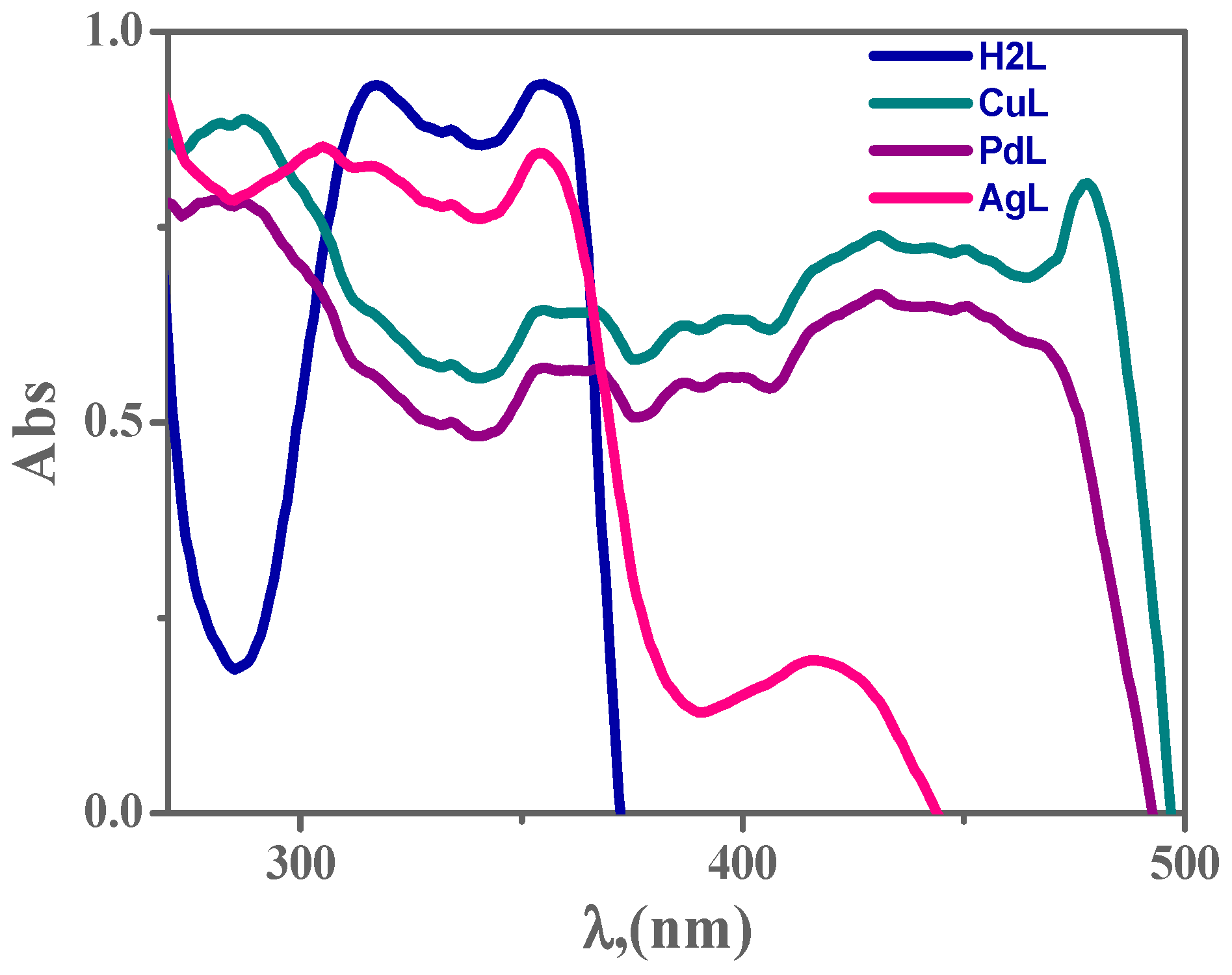
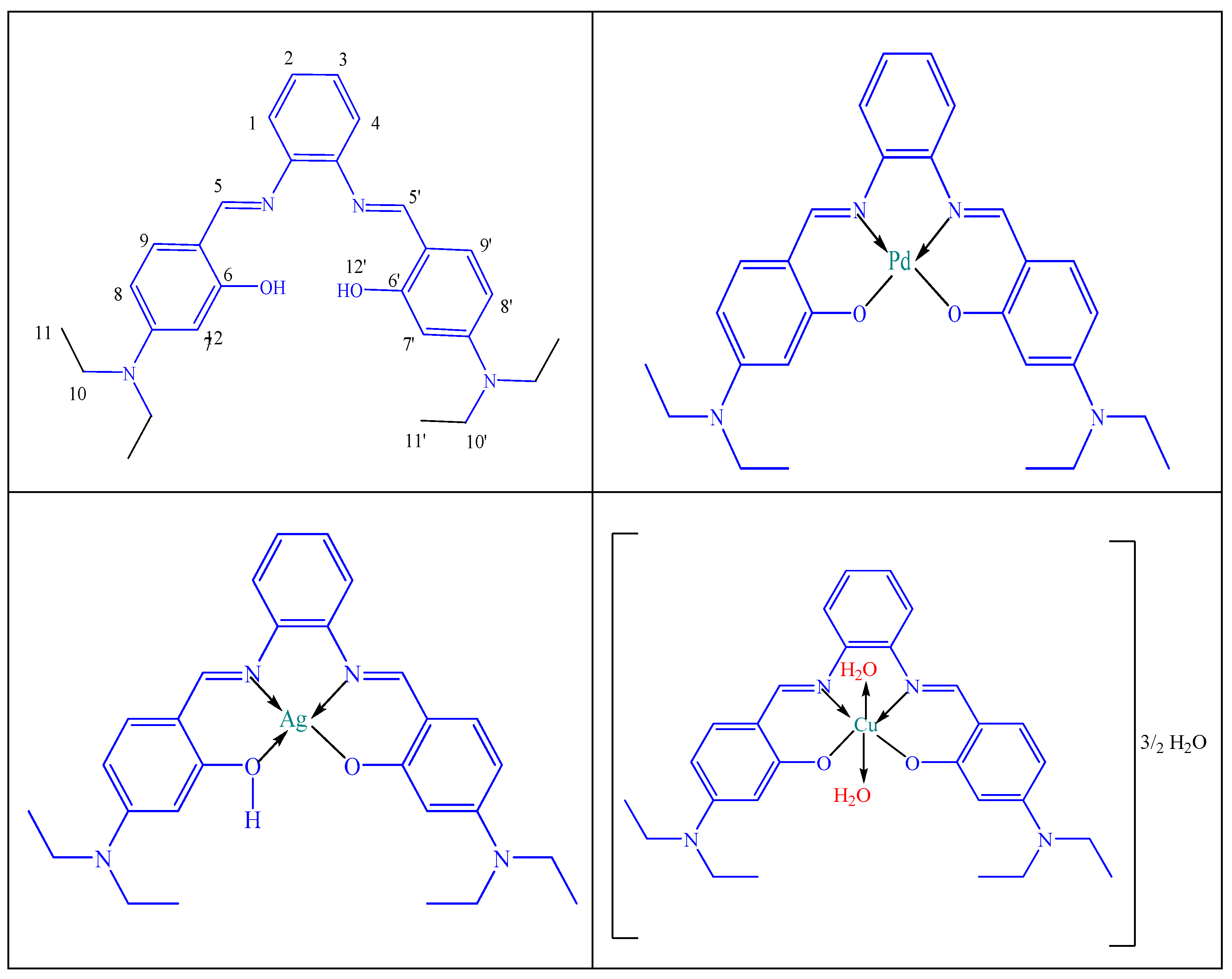

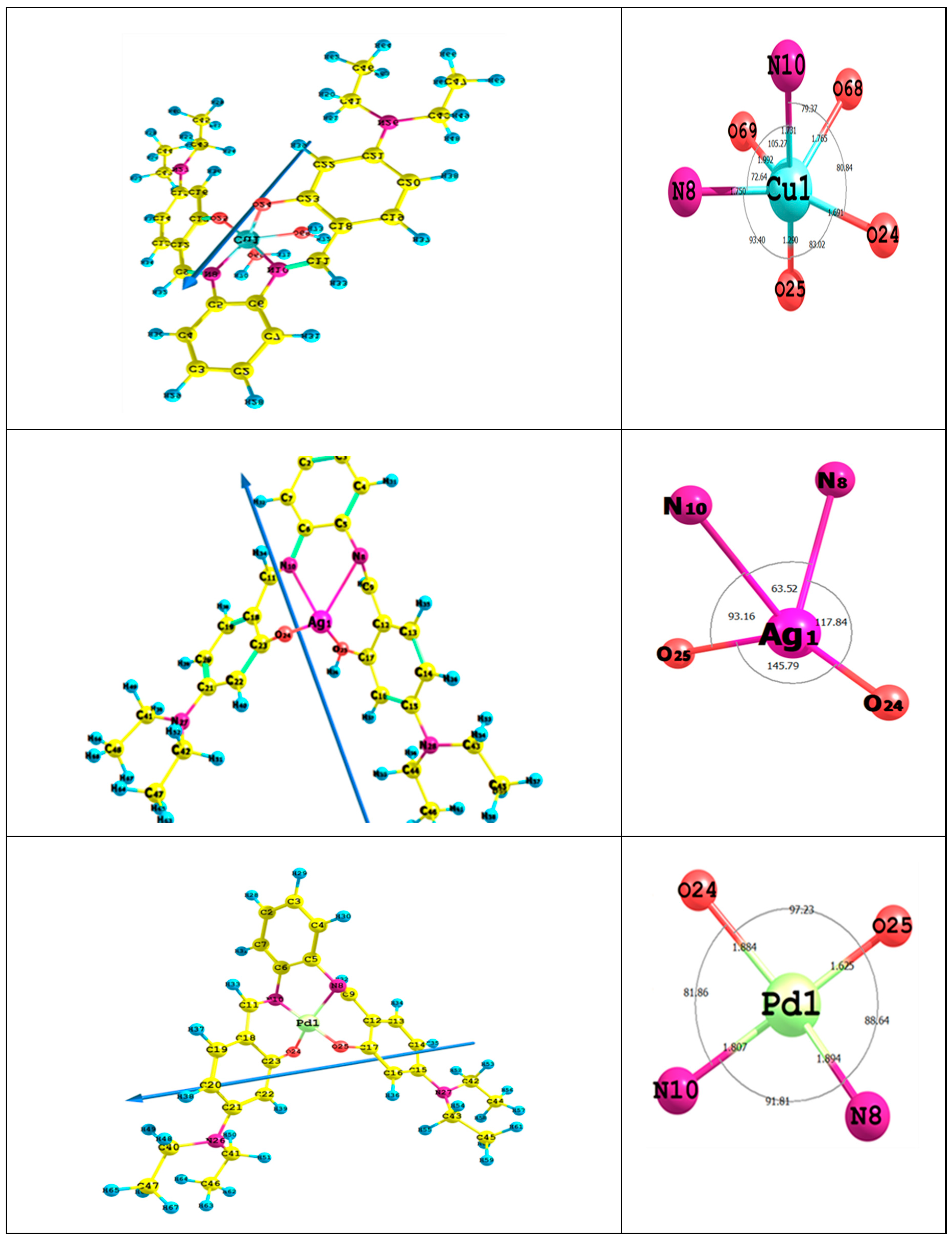
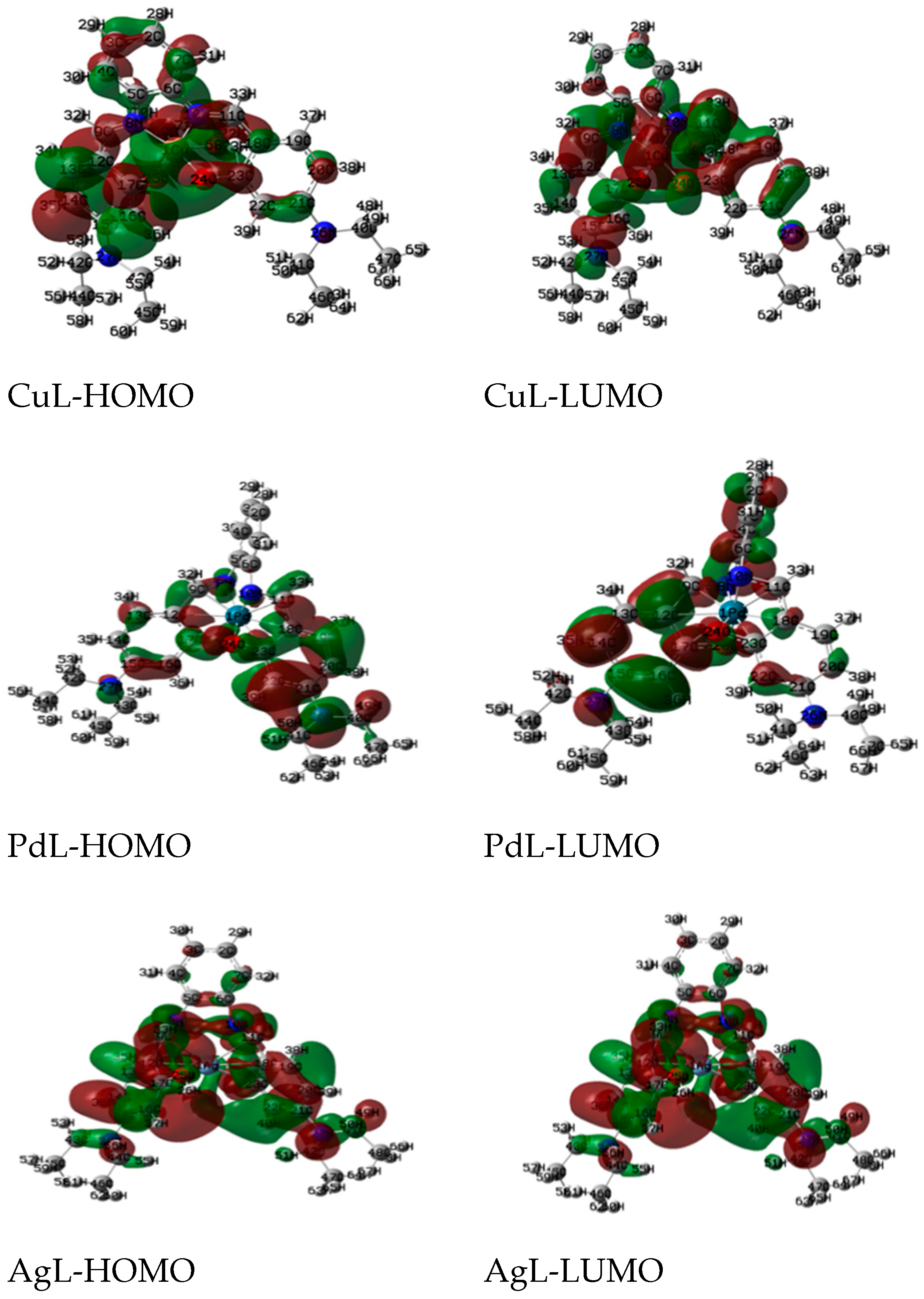
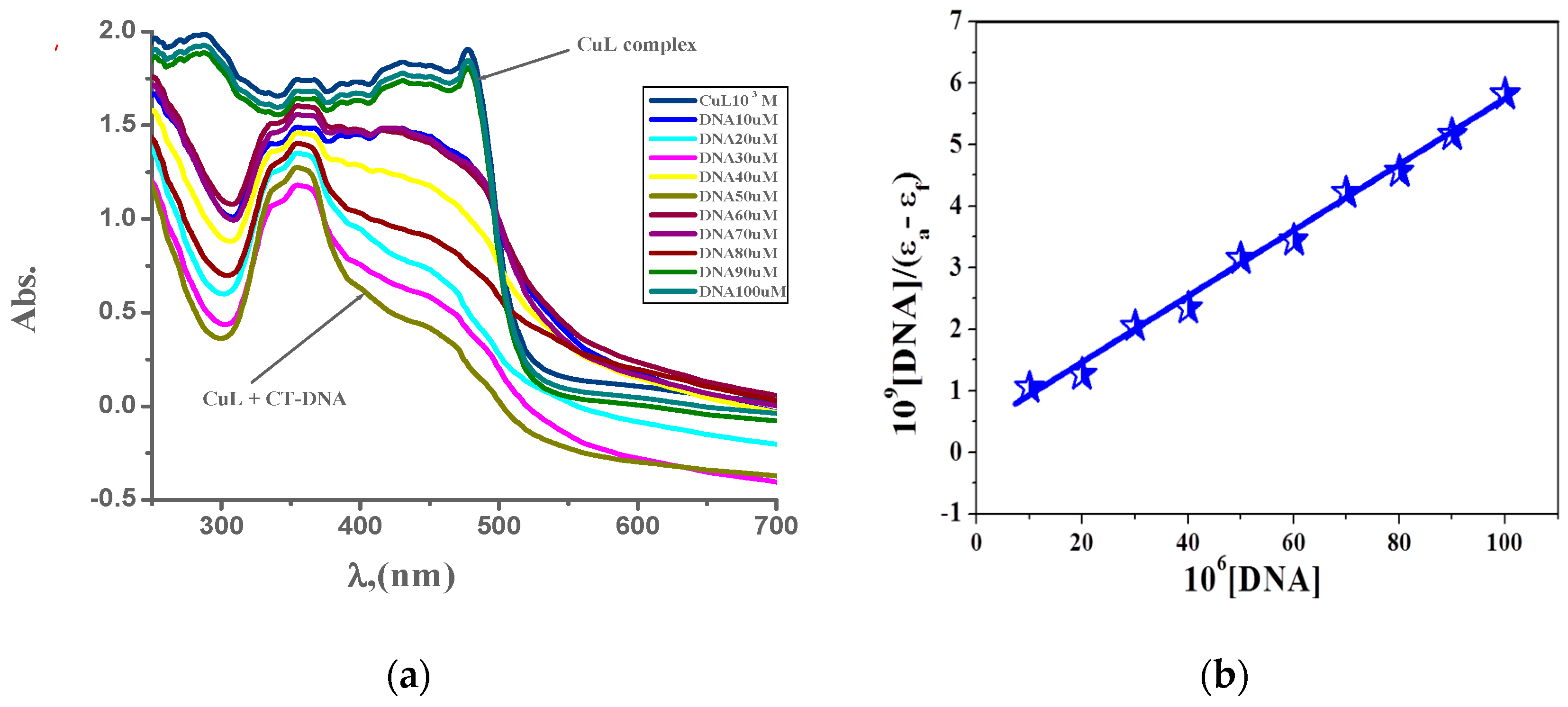
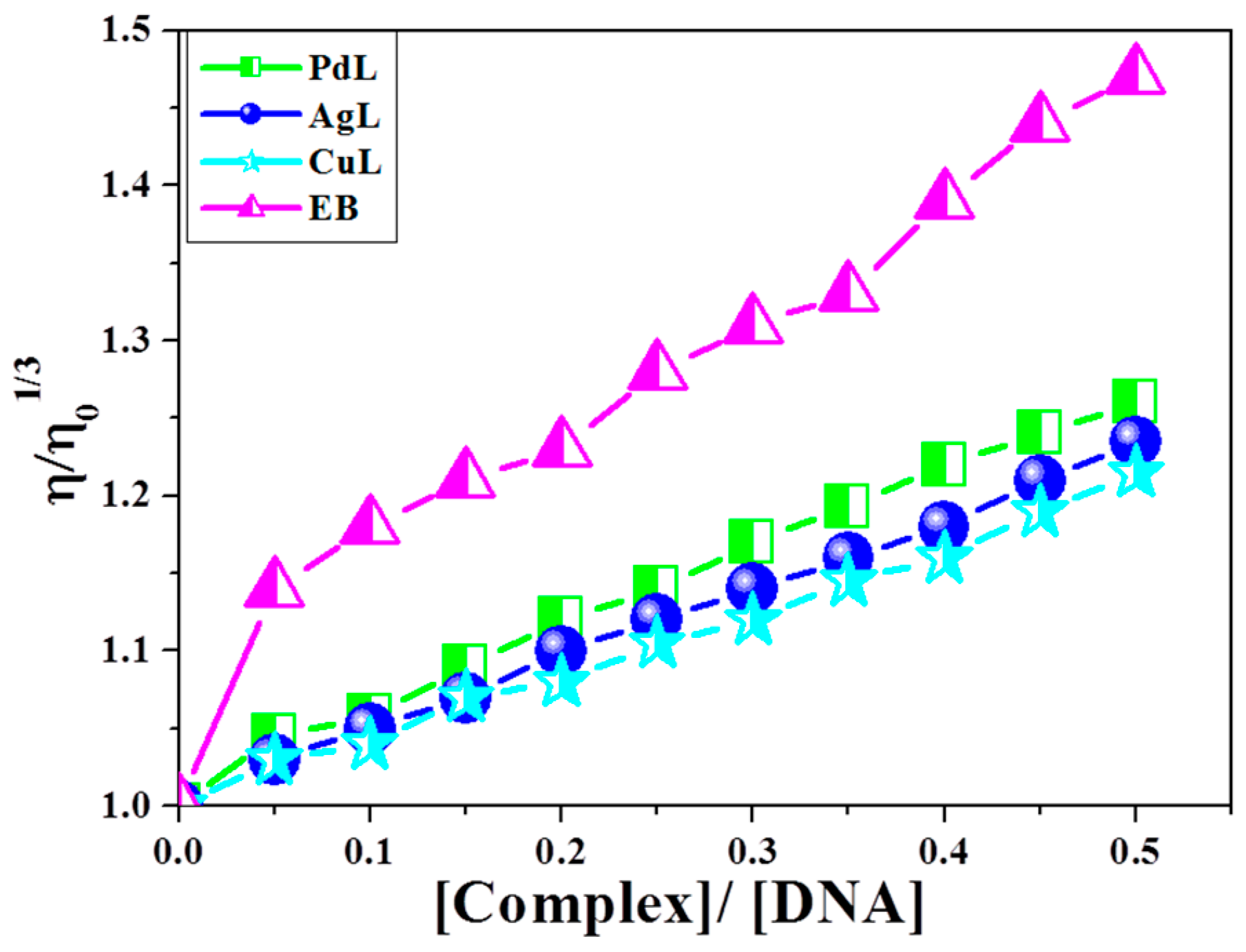
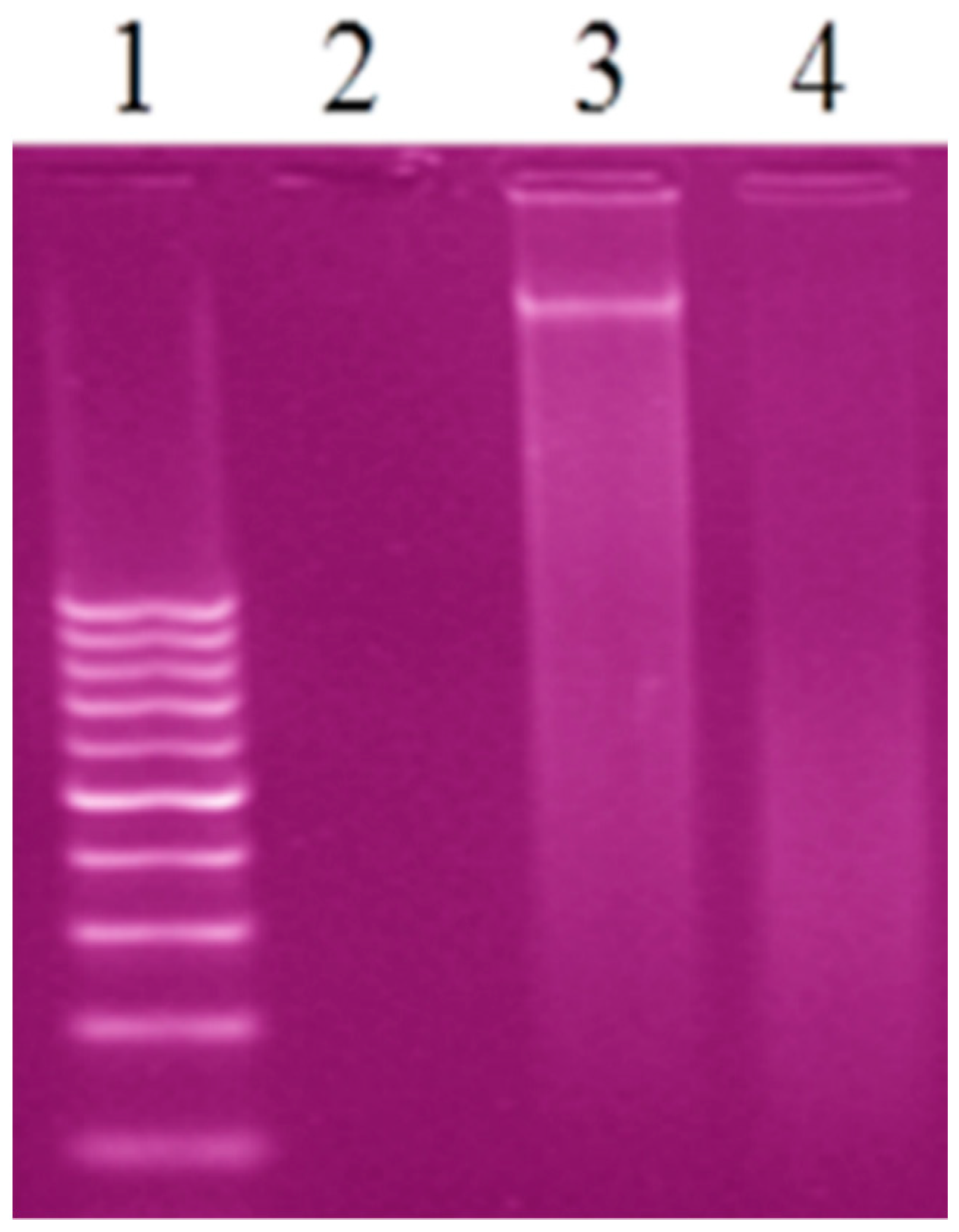

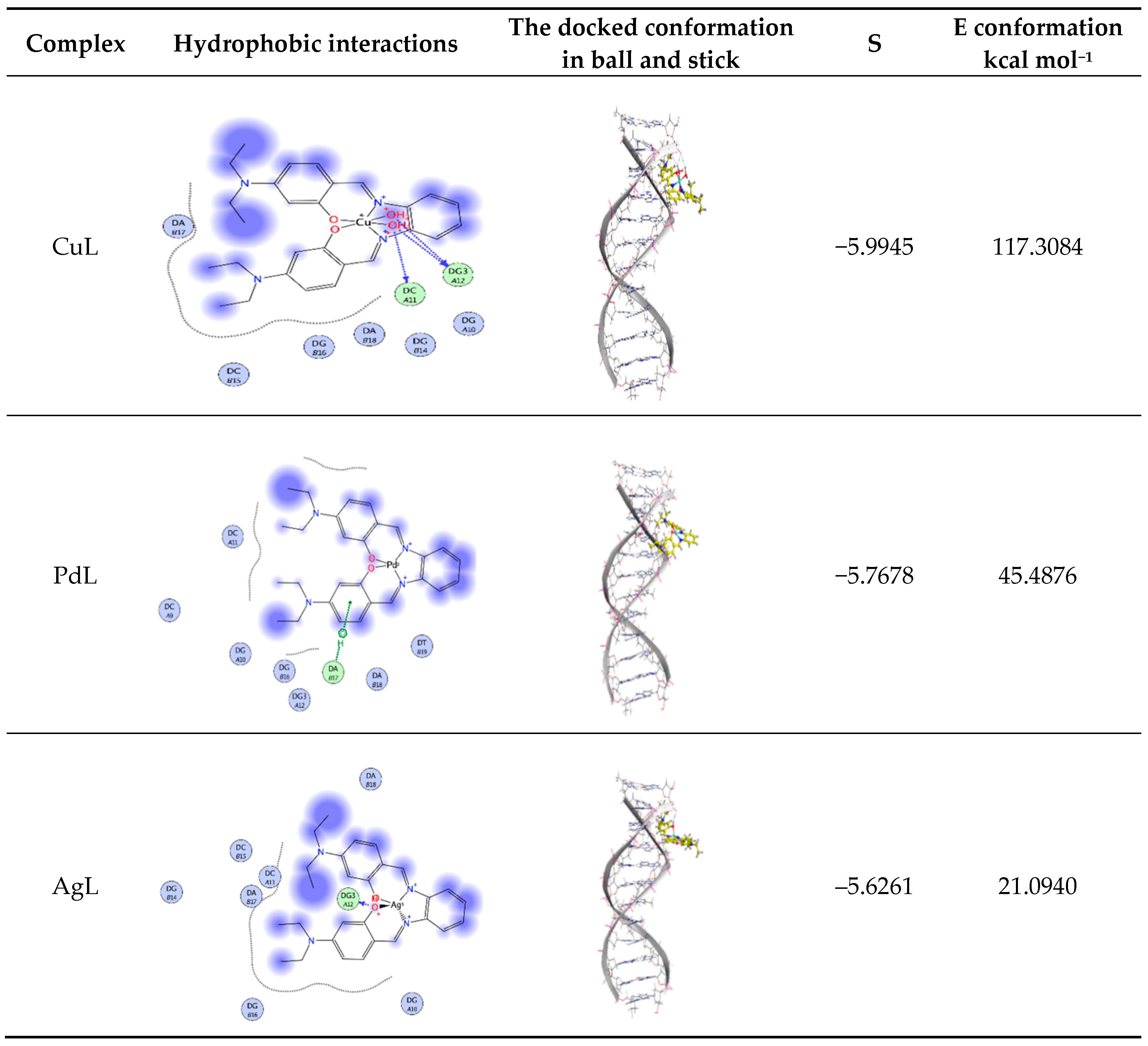
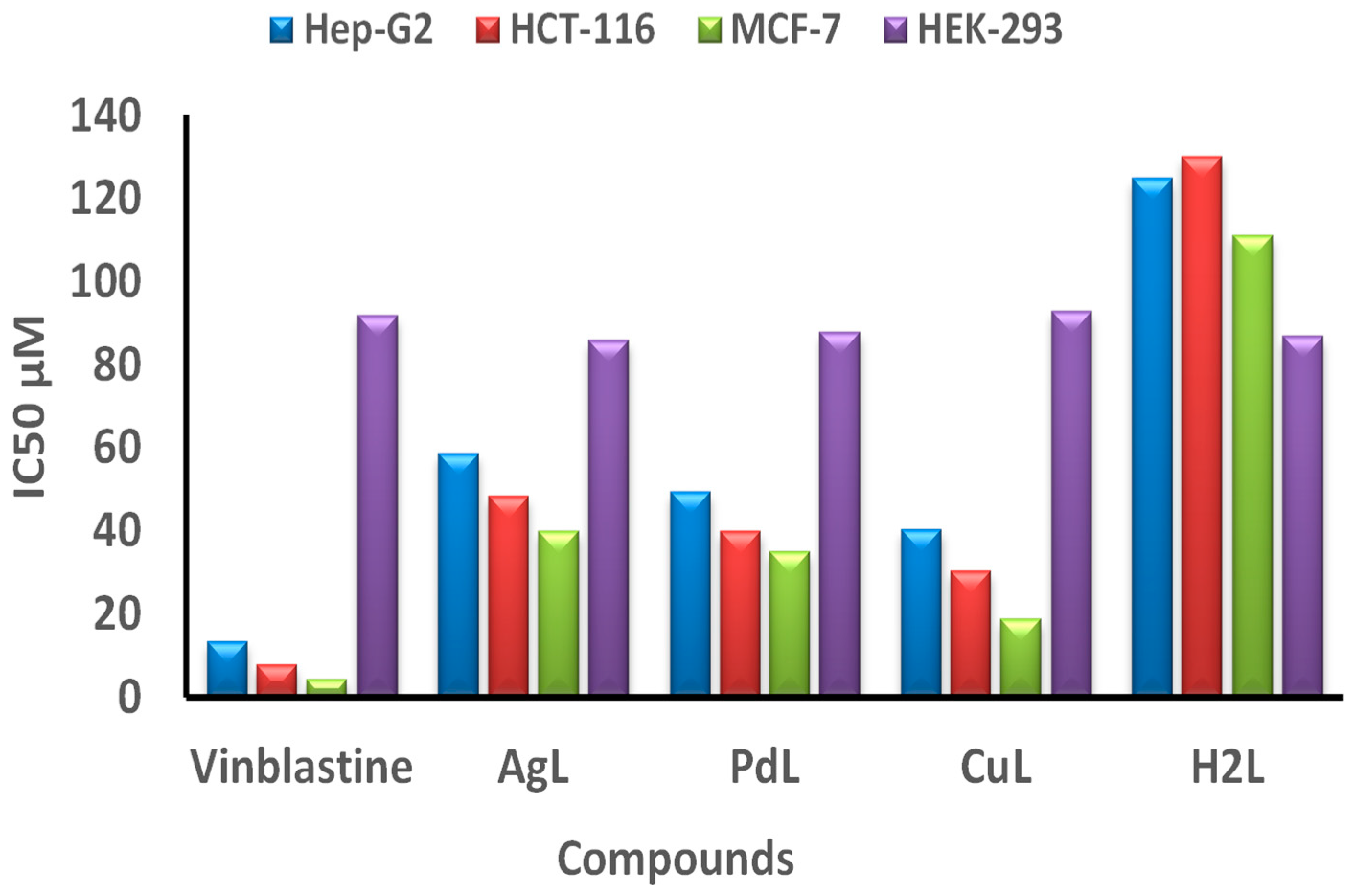
| Compounds | υ(OH)/H2O | υ CH) ar | υ (C=N) | υ (C-O) | υ (M-O) | υ (M-N) |
|---|---|---|---|---|---|---|
| H2L | 3357 | 3044 | 1635 | 1279 | --- | --- |
| CuL | 3418 | 3061 | 1618 | 1252 | 524 | 443 |
| PdL | --- | 3056 | 1613 | 1244 | 523 | 444 |
| AgL | 3437 | 3069 | 1624 | 1241 | 528 | 488 |
| Compound Molecular Formula | M. p. (°C) | Molecular Weight | Color | Λm (Ω−1cm2 Mol−1) | μeff. (B. M.) | Analysis (%) Found (calc.) | ||
|---|---|---|---|---|---|---|---|---|
| H2L C28H34N4O2 | 124 | 458.0 | yellow | --- | --- | 73.46 (73.36) | 7.50 (7.42) | 12.30 (12.22) |
| [CuL(OH2)2].3/2H2O C28H39N4O5.5Cu | 180 | 582.5 | Dark brown | 19.4 | 1.56 | 57.55 (57.68) | 6.79 (6.69) | 9.55 (9.61) |
| PdL C28H32N4O2Pd | 250 | 562.4 | Dark brown | 3.1 | Diamagnetic | 59.84 (59.74) | 5.77 (5.68) | 9.85 (9.95) |
| AgL C28H33N4O2Ag | < 300 | 564.8 | Dark gray | 17.3 | Diamagnetic | 59.56 (59.49) | 5.74 (5.84) | 10.00 (9.91) |
| Complexes | Dec. Product | Dec. Temp (°C) | Weight Loss % | E± (kJ Mol−1) | A × 104 (s−1) | ΔS± (J Mol−1) | ΔH± (kJ Mol−1) | ΔG± (kJ Mol−1K−1) | |
|---|---|---|---|---|---|---|---|---|---|
| Found | Calc. | ||||||||
| CuL | 3/2 H2O | 25–100 | 4.72 | 4.63 | 13.00 | 4.60 | −17.63 | 12.17 | 13.93 |
| 2 H2O | 100–218 | 6.28 | 6.18 | −18.41 | 11.19 | 15.20 | |||
| C11H14N2 | 220–350 | 29.97 | 29.87 | −18.88 | 10.09 | 16.70 | |||
| C11H14N2O | 350–420 | 32.51 | 32.62 | −19.07 | 9.51 | 17.52 | |||
| C6H4 | 425–625 | 12.97 | 13.05 | −19.46 | 7.80 | 19.96 | |||
| Residue | CuO | <625 | 13.55 | 13.65 | --- | --- | --- | ||
| PdL | C10H13N | 30–260 | 26.02 | 26.14 | 29.00 | 2.8 | −19.08 | 26.84 | 31.80 |
| C11H14NO | 260–410 | 31.19 | 31.30 | −19.54 | 25.59 | 33.60 | |||
| C7H5N2 | 410–600 | 20.92 | 20.80 | −19.92 | 24.01 | 35.96 | |||
| Residue | PdO | <605 | 21.87 | 21.76 | --- | --- | --- | ||
| AgL | C11H14N2O | 37–270 | 33.54 | 33.64 | 27.00 | 2.6 | −19.19 | 24.75 | 29.93 |
| C11H15N2O | 274–425 | 33.91 | 33.81 | −19.65 | 23.47 | 31.82 | |||
| C6H4 | 430–605 | 13.55 | 13.45 | −20.00 | 21.97 | 34.07 | |||
| Residue | 1/2Ag2O | <610 | 20.40 | 20.50 | --- | --- | --- | ||
| Parameters | H2L | PdL | AgL | CuL |
|---|---|---|---|---|
| ET (a.u.) | −1457.219 | −2247.595 | −2395.74 | −2220.60 |
| EHOMO a. u. | −0.1778 | −0.1598 | −0.1854 | −0.1199 |
| ELUMO a. u. | −0.0336 | −0.1176 | −0.1282 | −0.0428 |
| Eg, eV | 3.9222 | 1.1478 | 1.5558 | 2.0971 |
| I, eV | 4.8361 | 4.3465 | 5.0428 | 3.2368 |
| A, eV | 0.9139 | 3.1987 | 3.4870 | 1.1641 |
| χ, eV | 2.8750 | 3.7590 | 4.2649 | 2.2004 |
| ŋ, eV | 1.9611 | 0.5603 | 0.7779 | 1.0363 |
| S, eV−1 | 0.2549 | 0.8924 | 0.6427 | 0.4825 |
| V, eV | −2.8750 | −3.7590 | −4.2649 | −2.2004 |
| Inhibition Zone (mm) | ||||||
|---|---|---|---|---|---|---|
| Compounds | E. coli (-ve) | B. subtilis (+ve) | S. aureus (+ve) | |||
| Concentration (mg/μL) | 10 | 20 | 10 | 20 | 10 | 20 |
| H2L | 5 ± 0.33 | 9 ± 0.15 | 7 ± 0.17 | 15 ± 0.21 | 6 ± 0.33 | 13 ± 0.53 |
| CuL | 16 ± 0.14 | 33 ± 0.54 | 19 ± 0.09 | 43 ± 0.17 | 17 ± 0.52 | 39 ± 0.23 |
| PdL | 15 ± 0.27 | 31 ± 0.26 | 18 ± 0.09 | 39 ± 0.12 | 16 ± 0.17 | 36 ± 0.19 |
| AgL | 19 ± 0.292 | 36 ± 0.19 | 23 ± 0.19 | 48 ± 0.54 | 20 ± 0.41 | 42 ± 0.11 |
| Gentamycin | 21 ± 0.81 | 41 ± 0.43 | 27 ± 0.25 | 52 ± 0.82 | 26 ± 0.93 | 46 ± 0.27 |
| Compounds | Inhibition Zone (mm) | |||||
|---|---|---|---|---|---|---|
| C. albicans | A. flavus | T. rubrum | ||||
| Concentration (mg/μL) | 10 | 20 | 10 | 20 | 10 | 20 |
| H2L | 6 ± 0.15 | 10 ± 0.15 | 5 ± 0.18 | 9 ± 0.61 | 4 ± 0.15 | 7 ± 0.14 |
| CuL | 18 ± 0.32 | 30 ± 0.18 | 16 ± 0.42 | 27 ± 0.11 | 14 ± 0.31 | 24 ± 0.53 |
| PdL | 16 ± 0.13 | 27 ± 0.34 | 14 ± 0.15 | 25 ± 0.19 | 9 ± 0.42 | 20 ± 0.51 |
| AgL | 22 ± 0.45 | 35 ± 0.35 | 18 ± 0.35 | 30 ± 0.29 | 16 ± 0.22 | 25 ± 0.40 |
| Fluconazole | 23 ± 0.45 | 36 ± 0.52 | 18 ± 0.59 | 33 ± 0.78 | 14 ± 0.81 | 25 ± 0.80 |
| Compound | The Minimum Inhibitory Concentrations (mg/mL) | |||||
|---|---|---|---|---|---|---|
| E. coli (-ve) | B. subtilis (+ve) | S. aureus(+ve) | C. albicans | A. flavus | T. rubrum | |
| H2L | 7.50 | 6.00 | 5.75 | 5.75 | 5.50 | 7.25 |
| CuL | 2.75 | 2.00 | 2.50 | 1.75 | 2.25 | 2.75 |
| PdL | 3.25 | 3.00 | 3.00 | 2.75 | 2.75 | 3.00 |
| AgL | 2.00 | 1.00 | 1.50 | 0.75 | 1.25 | 1.75 |
| Gentamycin | 1.25 | 0.75 | 1.00 | - | - | - |
| Fluconazole | 0.50 | 0.85 | 1.05 | |||
| Control (DMSO) | 0.00 | 0.00 | 0.00 | 0.00 | 0.00 | 0.00 |
| The Activity Index (%) | ||||||
|---|---|---|---|---|---|---|
| Compound | E. coli | B. subtilis | S. aureus | C. albicans | A. flavus | T. rubrum |
| H2L | 22.5 | 29.41 | 28.88 | 27.02 | 28.12 | 26.92 |
| CuL | 82.5 | 84.31 | 86.66 | 81.08 | 84.37 | 76.90 |
| PdL | 77.5 | 76.47 | 80.00 | 72.92 | 78.12 | 92.30 |
| AgL | 90 | 94.11 | 93.33 | 94.59 | 93.75 | |
| Complex | λmax Free (nm) | λmax Bound (nm) | Type of Chromism | ∆ n | Chromism (%) a | Binding Constant × 105 | ∆G k J mol−1 |
|---|---|---|---|---|---|---|---|
| CuL | 239 | 240 | Hypo | 1 | 7.25 | 1.20 | −28.97 |
| 363 | 357 | −6 | 8.05 | ||||
| PdL | 239 | 240 | Hypo | 1 | 8.51 | 1.73 | −29.88 |
| 358 | 357 | −1 | 9.47 | ||||
| 252 | 251 | −1 | 10.94 | ||||
| AgL | 239 | 238 | Hypo | −1 | 11.92 | 1.54 | −29.59 |
| 355 | 356 | 1 | 11.49 |
Publisher’s Note: MDPI stays neutral with regard to jurisdictional claims in published maps and institutional affiliations. |
© 2020 by the authors. Licensee MDPI, Basel, Switzerland. This article is an open access article distributed under the terms and conditions of the Creative Commons Attribution (CC BY) license (http://creativecommons.org/licenses/by/4.0/).
Share and Cite
Abdel-Rahman, L.H.; Adam, M.S.; Abu-Dief, A.M.; Ahmed, H.E.-S.; Nafady, A. Non-Linear Optical Property and Biological Assays of Therapeutic Potentials Under In Vitro Conditions of Pd(II), Ag(I) and Cu(II) Complexes of 5-Diethyl amino-2-({2-[(2-hydroxy-Benzylidene)-amino]-phenylimino}-methyl)-phenol. Molecules 2020, 25, 5089. https://doi.org/10.3390/molecules25215089
Abdel-Rahman LH, Adam MS, Abu-Dief AM, Ahmed HE-S, Nafady A. Non-Linear Optical Property and Biological Assays of Therapeutic Potentials Under In Vitro Conditions of Pd(II), Ag(I) and Cu(II) Complexes of 5-Diethyl amino-2-({2-[(2-hydroxy-Benzylidene)-amino]-phenylimino}-methyl)-phenol. Molecules. 2020; 25(21):5089. https://doi.org/10.3390/molecules25215089
Chicago/Turabian StyleAbdel-Rahman, Laila H., Mohamed S. Adam, Ahmed M. Abu-Dief, Hanan El-Sayed Ahmed, and Ayman Nafady. 2020. "Non-Linear Optical Property and Biological Assays of Therapeutic Potentials Under In Vitro Conditions of Pd(II), Ag(I) and Cu(II) Complexes of 5-Diethyl amino-2-({2-[(2-hydroxy-Benzylidene)-amino]-phenylimino}-methyl)-phenol" Molecules 25, no. 21: 5089. https://doi.org/10.3390/molecules25215089








